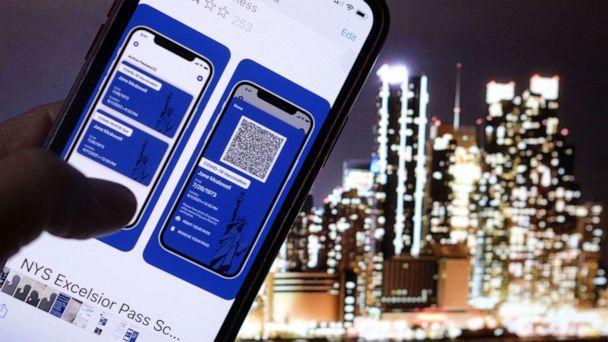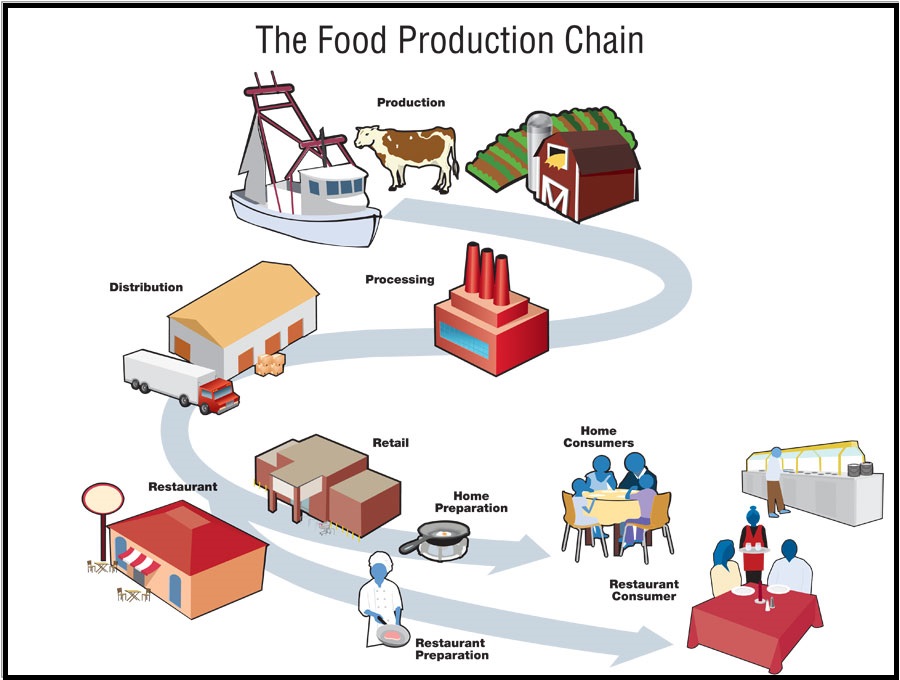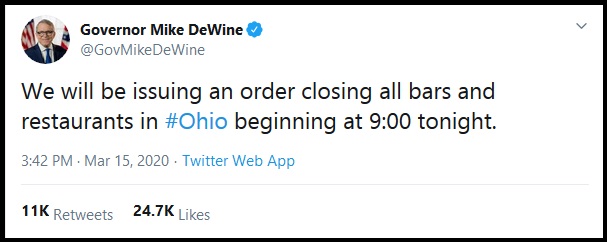The axiom of “the law of unintended consequences” has never been more appropriate than right now. In the background, as you are reading, there is a looming storm that is going to soon surface in the food supply chain, and the regional vaccine passports are going to make things worse.
To understand what is happening, it becomes necessary to give a more specific background on how the things work inside the supply chain that has been disrupted by government intervention. This is complex, but I hope to make it understandable for the average person.
 How do we avoid supply chain chaos? My response seems counterintuitive to those who do not understand this unique issue.
How do we avoid supply chain chaos? My response seems counterintuitive to those who do not understand this unique issue.
Effective immediately, or at least as soon as possible, every venue that can provide food on a commercial basis must be removed from all COVID regulations, including vaccine passports.
Restaurants, school lunchrooms, cafeterias, industrial kitchens, hotels, bars, food trucks and every possible venue for the delivery of freshly cooked meals must immediately be reactivated, and all terms and conditions for visiting those venues, like “vaccine passports”, must be cancelled quickly.
If they are not, and worse, if the restrictions expand beyond current status, there is going to be a worsening retail food crisis as the total food supply chain begins to collapse even further.
Beginning around 1990, the retail food industry, the supermarket and grocery business, began a process for automated replenishment. Walmart’s introduction into the grocery business was the trigger, as the massive internal supply chain created by the Arkansas company was the leading edge in growth and retail sales. Walmart began selling groceries, cheap groceries, by using their supply chain efficiencies to undercut prices within the retail food industry. It was a seismic change.
Soon other regional supermarket chains began to modify their ordering, purchasing and buying offices to add inventory efficiencies into their operational systems. If they did not adapt their inventory management, they would lose competitive price position.
As years passed, technology in the inventory management system became more and more important, as the thin margins inside the retail supermarket system looked to capitalize on automated replenishment. This is the beginning of “Just in Time” inventory within the retail food distribution network.
Computers began to make forecasts for products and shelves were replenished through a complex system of automated orders. Years of multi-SKU data was assembled to create forecasts for future orders.
Instead of clerks, managers and supermarket operators ordering products from store level, slowly those same people became responsible for only recording the amount of an existing item currently on the shelf. The computer algorithm -filled with historic data on consumer purchasing- would forecast the need and place the order. This system formed the cornerstone of automated replenishment, as computers told the buying offices how much of every item would be needed, and when.
Billions were invested by the industry, as a whole, to develop this complex replenishment system. Within the process of just in time ordering (JIT), slowly computers replaced humans in the ordering process. Retail stores no longer housed massive amounts of inventory. Warehouses that feed the stores no longer housed massive amounts of inventory awaiting the orders from the stores. Warehouses even changed their terminology to “retail distribution centers“, as they became hubs for distribution and not holding centers for inventory.
Years and years of refinements to this process continued as the computers learned in ever more granular detail how to trigger replenishment orders based on checkout scan data. Tens-of-millions continued to be invested in the latest tech software and scanning systems that would thin down the supply chain at each step.
In essence, the timeline from field to fork was also being reduced, as the total food supply chain inventory management system refined each year becoming more and more efficient at recognizing purchasing patterns and predicting sales.
 The value inventory efficiency to the industry was great.
The value inventory efficiency to the industry was great.
The cost of excess inventory to support sales was reduced, and the efficiencies of the Walmart purchasing, and supply chain excellence was being duplicated in every retailer.
Without excess inventory, the value of store inventory counted as “days on hand” was also reduced. This meant more profits for the retail outlets, as the overhead cost of their inventory was lowered.
Companies passed along these supply chain efficiencies in the form of lower prices to the consumer. This was, in very direct measures, the Walmart influence in the retail food supply industry. All regional supermarket chains were duplicating the Walmart supply chain excellence, and that allowed them to compete on price.
Eventually, what was once seen as a Walmart competitive advantage, became an industry-wide way of doing business. The retail food supply chain for grocery outlets was structurally and permanently changed. Every retail outlet was/is using some form of just-in-time inventory management with automated replenishment based on computer forecasts for purchasing needs. However, there is a downside…. less inventory in the total system means less capacity to deal with increased demand.
This supply chain system is best understood in reverse:
♦ The data from retail scanned sales is shared backwards into the supply chains, with retail grocery stores sharing their scan data with suppliers. The suppliers like Kraft foods then know exactly how much anticipated product is needed, by which retailers, where and when.
♦ The suppliers and manufacturers then share that information backwards into the food processing sector. The processors of raw material food now know what products are needed by the branded suppliers.
♦ The processors then share that information backwards in the supply chain to their raw material providers. Those are the protein conglomerates and farming groups. This is also where Big Ag makes import/export decisions and controls the prices for their own profitability.
The contracted commercial farmers, cattlemen, fishermen etc., all know -or are instructed- roughly what crops, pork, beef, chickens, poultry, etc. will be needed in the following season to provide to the processors, who provide to the manufacturers, who provide to the suppliers, who provide to the distribution centers, who provide to the retail stores. This is the complex system known as the retail food supply chain.
As you can see from above, this complex inventory management system originates with historic data from the stores and travels throughout the supply chain providing users at each step to assemble the data that pertains to their role. This is like thousands of interconnected gears in a finely tuned machine, and this is NOT a system that can be interrupted without consequence.
CTH warned in March 2020 [LINK HERE], when government first suggested that all retail food establishments (restaurants, lunchrooms, hotels, cafeterias, etc.) should shut down due to the pandemic, that closing 60% of fresh food distribution would be catastrophic for the total food supply chain.

“A government cannot just shut down 30 to 50 percent of the way civil society feeds themselves, without planning and advanced preparation for an alternative. Those who ARE the alternative, the retail food grocers, need time to prepare themselves (and their entire logistical system) for the incredible impact. Without preparation this is a man-made crisis about to get a lot worse.” (LINK)
Those decisions in 2020 triggered a cascading sequence of events that has yet to be fully understood. {Go Deep}
For 30+ years, the highly complex and data driven retail food supply chain, the delivery vehicle for 40+ percent of total food available, has become increasingly refined. Unfortunately, like a finely tuned watch, those refinements also mean the supply chain is vulnerable to unforeseen changes in the system.
The government upended the total food supply system by shifting 25 to 40% more customers into the retail grocery supply chain for their food. The supply chain we just explained cannot handle that level of stress. Operational capacities are reached very quickly throughout the system, and even the packaging of increased demand is an issue. Suppliers for packaging also have capacity constraints.
Processors cannot process enough. Manufacturers cannot manufacture enough. Suppliers cannot supply enough. Distribution centers cannot distribute enough, and stores cannot stock enough.
The entire food delivery system is not designed for this and cannot reasonably be expected to adjust on this scale; it is just not feasible. We are seeing the cascading results of this in our supermarkets right now. People are starting to worry, and there is good reason to worry. {Go Deep}
This is where the vaccine mandate and mandatory vaccine passports make things worse. Even a small amount of excess demand right now is causing exponential problems for a system that is already beyond capacity. The system stressors, specifically the demand side, need to be reduced.
If just 10% of a population, within a metropolitan region of consumers, are blocked from restaurants or food venues because they are unvaccinated, they are going to put stress on the alternative, the grocery supply chain…. meaning, more empty shelves and cases. Those empty shelves impact the vaccinated and unvaccinated alike.
Restricting restaurant capacity, shutting food venues, closing school lunchrooms, shutting or restricting cafeterias or hotels, blocking venue access by vaccine restrictions, all of these have damaging unintended consequences to the food delivery system. We need every possible fresh food delivery system open for everyone…. and that needs to happen quickly.
Additionally, the trucker vaccine mandate -scheduled to go into effect for domestic freight haulers on January 22nd- needs to be cancelled fast.
If these mandates, COVID restrictions, passports and gateways continue as blocks in the system, it is very likely the shortages in the food supply chain will only worsen.
It is only going to take a few visits of worsening empty shelves before “national food security” panic becomes a self-fulfilling prophecy.
MASSACHUSETTS – BOSTON — Vaccinated state residents are now able to access a digital record of their COVID-19 vaccine history, including a scannable QR code, that could be stored on their smartphone and presented to businesses requiring immunizations for entry.
Gov. Charlie Baker’s administration is rolling out the “COVID-19 SMART Health Care” just as the city of Boston prepares for a new vaccine requirement to take effect at the end of the week in all restaurants, gyms and entertainment venues.
Boston is one of the few cities in the state to adopt a universal vaccine requirement for certain businesses. (read more)

